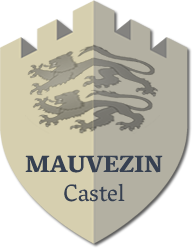Mr Albin Bibal
Albin Bibal, a business owner, politician, and philanthropist, was born on August 20, 1841 and died on February 13, 1920 in Esclassan, Gers, where he owned a castle.
He was first a stonemason and contractor, and was responsible for building the bridge on the Adour river in Bayonne as well as various works on the Landes railway lines. Unfortunately, he lost all of his money as a result of several bad business deals with the Compagnie des chemins de fer du Midi (Southern Railway). He was only 19 at the time. He then took a job as a public works engineer and took part in the construction of water diversion works in the Alps, then of the railway between Ganges and Le Vigan, Gard.
In 1874, he started a business working for railway companies in the south of France and Spain, on the Tarragone-Saragosse line. He worked on the rail link between Auch and Lannemezan. Although it was never finished, some of his works still exist to this day. As he was convinced that there was a need for a railway to Spain, he wrote a dissertation on the crossing of Central Pyrenees. It has become relevant again and is subject to lively debate in some valleys.
After becoming successful in business, he began his political career. He was elected mayor of Esclassan in 1886, arrondissement municipal councillor in 1892, general councillor of the canton of Masseube in 1895, president of the Gers departmental council in 1897 and 1898, and mayor of Masseube in 1900. He encouraged the breeding of mules which turned Masseube into a major centre for that particular trade with Spain. He also encouraged the breeding of geese, meaning that canneries in the Gers still owe him a debt of gratitude!
Albin Bibal and the Mauvezin Castle
As he was vividly interested in regional culture, Bibal wrote The Chronological History of the Old Mauvezin Castle, as well as The Old Castle of Mauvezin and Its Motto, and a book containing no less than 648 biographies of notabilities from Gascogne. The idea came to his mind as he was visiting the church of Capbreton in which the names of sailors gone missing are listed.
Bibal bought the Mauvezin Castle from the heirs of Achille Jubinal. He started the restoration work and intended to rebuild the access ramp and the drawbridge. The town objected, in order to keep the town cemetery accessible. He had to settle for a cast iron staircase to allow access to the castle. On March 28, 1907, he donated the castle to the Escòla Gaston Febus, of which he was a member. The Escòla officially took ownership of the castle on August 23, 1907. On that momentous occasion, several hundred guests came from all over Gascogne. After a visit of the castle followed by a shared meal, a “cour d’Amour” began (literally “court of love”, traditional games dating back to the times of the troubadours) with speeches, poetry, tales, music, and singing. That night, the guests left for Cauterets where “Félibrées” (a Félibres gathering) were to take place over the span of two days. That memorable event was immortalised by an artist from Bordeaux — the painting is displayed in the lower room of the main tower and depicts the event with its various guests. Among them, Adrien Planté, capdau (president) of the Escòla, and the abbot Pailhé, priest of the Mauvezin parish and curator until 1943, can easily be identified.






